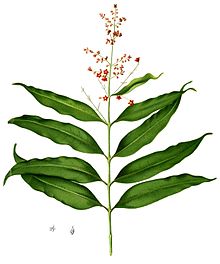Cratoxylum sumatranum
| Cratoxylum sumatranum | |
|---|---|

| |
| Scientific classification | |
| Kingdom: | Plantae |
| Clade: | Tracheophytes |
| Clade: | Angiosperms |
| Clade: | Eudicots |
| Clade: | Rosids |
| Order: | Malpighiales |
| Family: | Hypericaceae |
| Genus: | Cratoxylum |
| Species: | C. sumatranum
|
| Binomial name | |
| Cratoxylum sumatranum | |
| Synonyms | |
| |
Cratoxylum sumatranum is a species of flowering plant in the Hypericaceae family. Found in Southeast Asia, it grows up to 51 m (167 ft) tall and is harvested locally for timber and fuel.
Description
[edit]The tree may grow up to 51 m (167 ft) tall and 80 cm (31 in) diameter at breast height, with cracked and fissured bark. The stems produce whitish-yellowish latex. The leaves have an opposite arrangement, are simple, elliptic and a glossy rich green. Its flowers are 5-parted and clustered on terminal panicles. They are small (approximately 8mm in diameter), reddish with white linings around the petals. The fruits, which appear in July, are approximately 8mm long, yellow-brown-black capsules, filled with many small winged seeds.[3]
Taxonomy
[edit]The species was originally placed in the defunct genus Elodes under the name Elodes sumatrana. It was moved into Cratoxylum as C. sumatranum in 1856 by Carl Ludwig Blume. Two subspecies are recorded:[4]
- C. sumatranum subsp. blancoi (Blume) Gogelein - Philippines
- C. sumatranum subsp. sumatranum - the nominate infraspecific - Malesia
Distribution and habitat
[edit]Cratoxylum sumatranum is indigenous to Southeast Asia, including Borneo, Malaya, and the Philippines.[4] It is found in disturbed open areas, especially on hillsides and ridges on clay or sandy soils.[5]
Uses
[edit]The plant is harvested locally and used for its timber and for fuel or charcoal.[5] A 2021 study demonstrated that bark extracts from the species exhibited antimalarial capabilities in a laboratory setting, and could have applications as an antimalarial drug.[6]
References
[edit]- ^ Botanic Gardens Conservation International (BGCI) & IUCN SSC Global Tree Specialist Group (2019) [amended version of 2018 assessment]. "Cratoxylum sumatranum". IUCN Red List of Threatened Species. 2019: e.T135803484A144795114. doi:10.2305/IUCN.UK.2018-2.RLTS.T135803484A144795114.en. Retrieved 10 December 2023.
- ^ Silk, Ferry. "Cratoxylum sumatranum". Plants of Southeast Asia. Retrieved 2012-01-03.
- ^ "Kansilay(Cratoxylum sumatranum)". Archived from the original on 2012-04-25. Retrieved 2012-01-03.
- ^ a b "Cratoxylum sumatranum (Jack) Blume". Plants of the World Online. Royal Botanic Gardens, Kew. Retrieved 3 November 2024.
- ^ a b "Cratoxylum sumatranum - Useful Tropical Plants". tropical.theferns.info. Retrieved 2024-10-14.
- ^ Tumewu, Lidya; Wardana, Fendi Yoga; Ilmi, Hilkatul; Permanasari, Adita Ayu; Hafid, Achmad Fuad; Widyawaruyanti, Aty (2021-06-25). "Cratoxylum sumatranum stem bark exhibited antimalarial activity by Lactate Dehydrogenase (LDH) assay". Journal of Basic and Clinical Physiology and Pharmacology. 32 (4): 817–822. doi:10.1515/jbcpp-2020-0394. ISSN 2191-0286.



